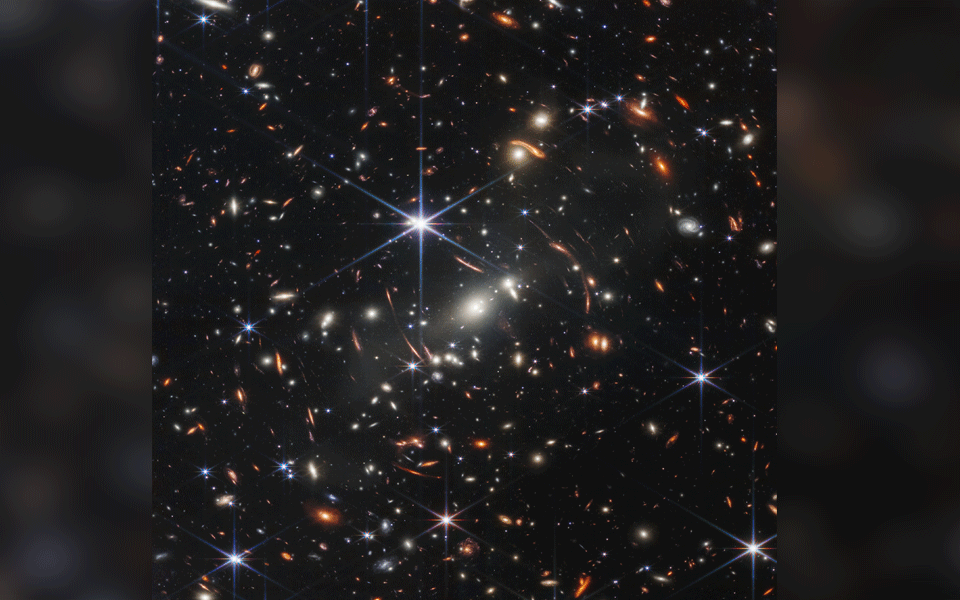Washington(AP): Our view of the universe just expanded: The first image from NASA's new space telescope unveiled Monday is brimming with galaxies and offers the deepest look of the cosmos ever captured.
The first image from the 10 billion James Webb Space Telescope is the farthest humanity has ever seen in both time and distance, closer to the dawn of time and the edge of the universe. That image will be followed Tuesday by the release of four more galactic beauty shots from the telescope's initial outward gazes.
The deep field" image released at a White House event is filled with lots of stars, with massive galaxies in the foreground and faint and extremely distant galaxies peeking through here and there. Part of the image is light from not too long after the Big Bang, which was 13.8 billion years ago.
Seconds before he unveiled it, President Joe Biden marveled at the image he said showed the oldest documented light in the history of the universe from over 13 billion -- let me say that again -- 13 billion years ago. It's hard to fathom.
The busy image with hundreds of specks, streaks, spirals and swirls of white, yellow, orange and red is only one little speck of the universe, NASA Administrator Bill Nelson said.
The pictures on tap for Tuesday include a view of a giant gaseous planet outside our solar system, two images of a nebula where stars are born and die in spectacular beauty and an update of a classic image of five tightly clustered galaxies that dance around each other.
The world's biggest and most powerful space telescope rocketed away last December from French Guiana in South America. It reached its lookout point 1 million miles (1.6 million kilometers) from Earth in January. Then the lengthy process began to align the mirrors, get the infrared detectors cold enough to operate and calibrate the science instruments, all protected by a sunshade the size of a tennis court that keeps the telescope cool.
The plan is to use the telescope to peer back so far that scientists will get a glimpse of the early days of the universe about 13.7 billion years ago and zoom in on closer cosmic objects, even our own solar system, with sharper focus.
Webb is considered the successor to the highly successful, but aging Hubble Space Telescope. Hubble has stared as far back as 13.4 billion years. It found the light wave signature of an extremely bright galaxy in 2016. Astronomers measure how far back they look in light-years with one light-year being 5.8 trillion miles (9.3 trillion kilometers).
Webb can see backwards in time to just after the Big Bang by looking for galaxies that are so far away that the light has taken many billions of years to get from those galaxies to our telescopes, said Jonathan Gardner, Webb's deputy project scientist said during the media briefing.
How far back did that first image look? Over the next few days, astronomers will do intricate calculations to figure out just how old those galaxies are, project scientist Klaus Pontoppidan said last month.
The image is spectacularly deeper (than a similar one taken by Hubble), but it's unclear how far back we're looking,? Richard Ellis, professor of astrophysics at University College London, said by email. More info is needed.
The deepest view of the cosmos is not a record that will stand for very long, Pontoppidan said, since scientists are expected to use the Webb telescope to go even deeper.
Thomas Zurbuchen, NASA's science mission chief said when he saw the images he got emotional and so did his colleagues: It's really hard to not look at the universe in new light and not just have a moment that is deeply personal.
At 21 feet (6.4 meters), Webb's gold-plated, flower-shaped mirror is the biggest and most sensitive ever sent into space. It's comprised of 18 segments, one of which was smacked by a bigger than anticipated micrometeoroid in May. Four previous micrometeoroid strikes to the mirror were smaller. Despite the impacts, the telescope has continued to exceed mission requirements, with barely any data loss, according to NASA.
NASA is collaborating on Webb with the European and Canadian space agencies.
I'm now really excited as this dramatic progress augurs well for reaching the ultimate prize for many astronomers like myself: pinpointing Cosmic Dawn the moment when the universe was first bathed in starlight, Ellis said.
Let the Truth be known. If you read VB and like VB, please be a VB Supporter and Help us deliver the Truth to one and all.
Bengaluru: Vidyaranyapura police have arrested four persons, including a man posing as a Police Sub-Inspector (PSI), for allegedly breaking into a house, threatening the occupants, and extorting money while wearing police uniforms.
The arrested accused have been identified as Mallikarjuna, Pramod, Vinay, and Hrithik.
Police said the accused had hatched a plan to pose as police personnel, conduct fake raids, and extort money from residents by intimidation.
ALSO READ: Bantwal police arrest two men for illegal sale of narcotics, seize two vehicles, 810 gm ganja
According to the police, Mallikarjuna had failed the PSI examination twice and later falsely projected himself as a PSI. He allegedly conducted photo shoots in his hometown, Siraguppa, wearing a police uniform, baton, cap, and shoes, claiming to be serving as a PSI in Bengaluru.
On December 7, the four accused allegedly went to the house of Naveen in the Vidyaranyapura limits, threatened him with a stick and an iron rod, and claimed they had information that he was selling ganja. Under the pretext of searching, they allegedly extorted ₹87,000 through bank transfer, ₹53,000 in cash kept in the house, and ₹2,000 from his wallet.
Following Naveen’s complaint, Vidyaranyapura police registered a case and launched an operation, leading to the arrest of all four accused. Police have seized ₹45,000 in cash and the car used to commit the crime.
Further investigation is underway.





